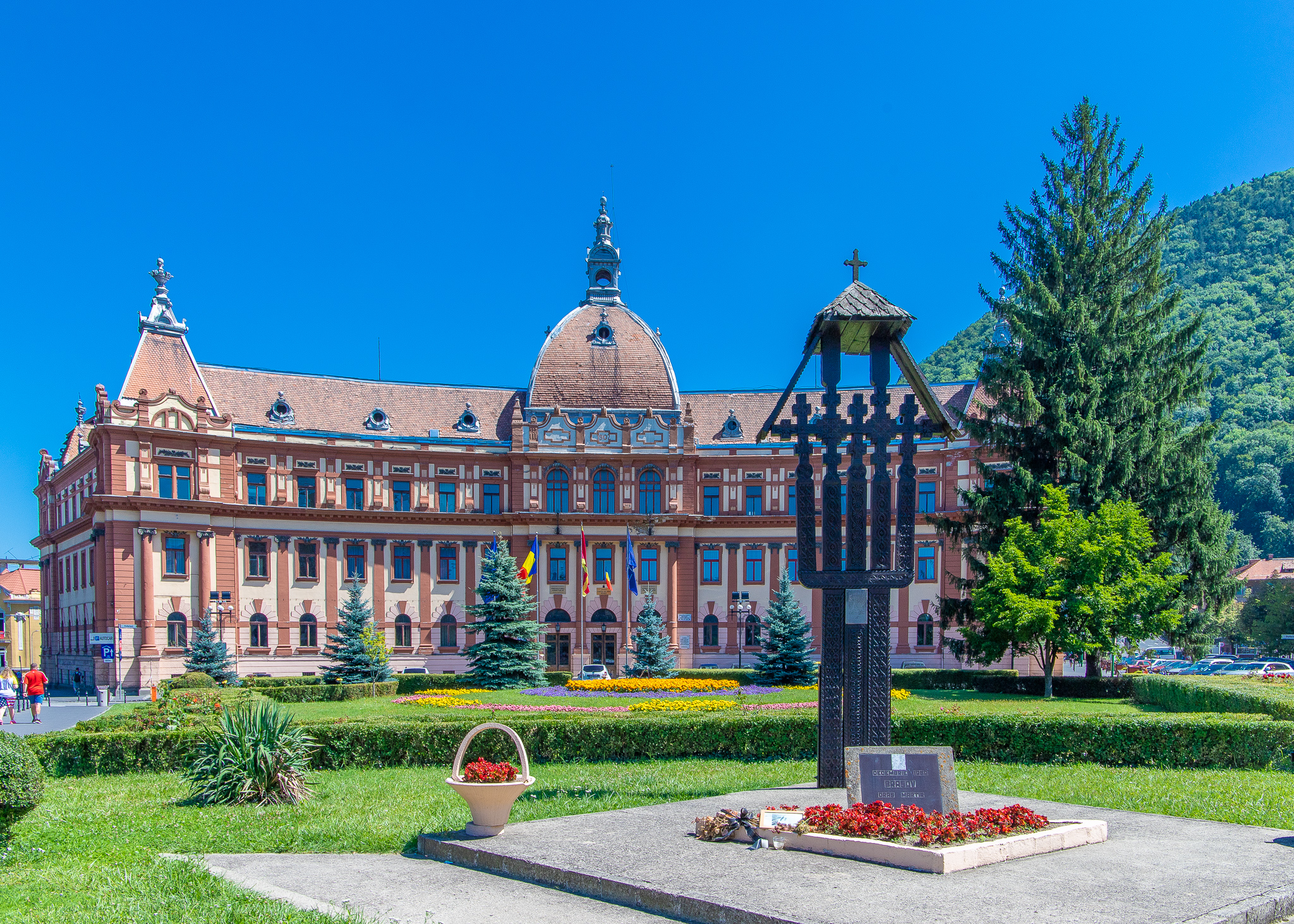We’re keen to check out Dracula’s Castle or as it’s more properly known, Bran Castle. Before we get there though, we still have unfinished business in Brasov to attend to first.
Dominating the Brasov skyline, both during the day and spectacularly at night, is Cetățuia de pe Strajă or the Brasov Citadel. Part of Brasov's outer fortification system, it was originally built in 1524 with wooden walls, before being replaced with the current stone bastions between 1554 and 1690 AD.
Brasov Citadel
As striking as it is from afar, it’s not open to public and up close, not nearly as nice.
Brasov Fort
Old Citadel Walls
However, if you’re keen to get up some hills (and unaware that there’s not really that much to see up there) then you will be rewarded with some pretty good views back down to Brasov Town.
View to town with the Black Church in the centre
At the foot of the hill which the citadel is perched upon, is the super cute Eastern Orthodox Church, Biserica Buna Vestire. Recently built between 1934 and 1937, its stark whiteness makes it stand out from miles away.
Biserica Buna Vestire
Only a short walk away from the church through Parcul Eroilor is the Brasov City Hall. In front there is a copy of the well-known statue of Lupa Capitolina which depicts a she-wolf and two suckling children, Romulus and Remus, the legendary founders of Rome. The link here is that the etymology of Romania, which was the name officially taken in 1861 at the union of Wallachia and Moldavia, is from the Latin Romani meaning "people from Rome," which was used to describe the descendants of colonists from Roman times in the 2nd century AD.
Capitoline Wolf and City Hall
The last of the magnificient buildings we saw in Brasov was the Consiliul Județean (Brasov Country Council Building) which was built in 1902.
Situated in front of the building is a memorial to the December 1989 Romanian Revolution. Romania was the one of last of the Central and Eastern European countries to overthrow their communist regimes and unlike the mostly peaceful revolutions in Poland, Hungary, East Germany, Czechoslovakia and Bulgaria, theirs was bloody and violent. In the end Romania’s President and one of Eastern Europe’s most brutal dictators, Nicolae Ceaușescu, was killed by firing squad.
Given the history in the region, Ceaușescu can probably count himself lucky that his head didn’t end up impaled upon a stake.
Unknown soldier statue in front of
Romania’s most recent bloody path segues nicely to its most bloodiest, that of the legend of Dracula which began with Bram Stoker’s Gothic novel originally published in 1897 and derived from vampire legends in the region. Most people attribute the main character in the novel, Count Dracula, as being based on the infamously barbaric Wallachian Prince, Vlad the Impaler. Born in the 15th century AD Vlad’s brutality is legendary, with his most well known act being the impaling of 30,000 enemy Turks.
Vlad was also known as Drăculea, meaning the “Son of Dracul” due to his father having received the surname Dracul after being appointed to a knightly order called the Order of the Dragon. In modern Romanian, drac evolved to mean “devil” and Stoker is thought to have picked the name Dracula after reading a book that revealed to him this translation.
While Bram Stoker never actually visited Transylvania, the Dracula legend and its association with Transylvania has grown adfinitum. Nearly everywhere you go in Romania, you’ll see signs of Vlad and people cashing in on his legend. This is epitomised by Bran Castle, a modern-day tourist attraction in Transylvania that is often referred to as Dracula's castle. However, Vlad never set foot in the castle, having lived 90km south of Bran, in a town called Târgoviște in the region of Wallachia. The only reason the castle is associated with Dracula is due to it being located in the mountains in a foggy and spooky area that you would believe might be a vampire’s lair.
Bran Caslte not looking so spooky in the beautiful sunlight
Bran Castle is situated in the town of Bran only some 30 kilometres from Brasov. Unfortunately no train leads there and when we visited the journy took over an hour thanks to all three roads leading into the area being under construction. With an hour long queue in front of us we chose to skip touring inside, which most people admit to being as “only average” and instead wandered across the road, over the Turcul River and into the wooded hills to receive a different viewpoint.
Bran Castle seen from the hillside opposite
All up we spent 30 minutes or so wandering around. Factoring in an hour or so for the queue and at least another 30 minutes to look inside the castle and you probably need at least 2 hours in Bran. An alternative is to pay for a pre-arranged tour which will enable you to skip the queue, which given the hot beating sun frying not only vampires but even us mere mortals in hindsight seemed a pretty good idea.
Usually the tours also through in a visit to the more impressive Rasnov Citadel which is situated about halfway between Bran and Brasov. The Fortress is located on a rocky hilltop 250 metres above the town of Rasnov and was built by Teutonic Knights as protection against invading Tartars before being enlarged by the local Saxons. The Fortress extensive defensive system included nine towers, two bastions and a drawbridge, meaning it only ever had to surrender once in over 500 years.
Having achieved our goal of visiting the place most associated with the legend of Dracula it’s now time to move on from Transylvania and spend our last few days in the capital of Romania, Bucharest.










